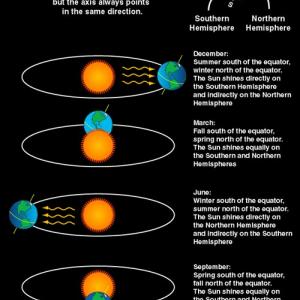College of Liberal Arts & Sciences
8A20.05 - Earth's Seasons
Place the Earth globe with the solar cell into the area lighted by the slide projector. As you tilt the Earth globe, the readings on the multimeter will change simulating the amount of sunlight received as the Earth season's change through out the year.
The Earth-Moon-Sun system will show the changing tilt of the Earth in relation to the sun as the Earth rotates around the Sun.
- Stephen W. Hughes, "Ferris Wheel Earth", TPT, Vol. 62, #7, Oct. 2024, p. 606.
- Margaret Stautberg Greenwood, "Geometry and the Cause of the Seasons: The Changing Hours of Daylight and Elevation Angle of the Sun at Noon", TPT, Vol. 60, #8, Nov. 2022, p. 694.
- Benjamin Oostra, "Introducing Earth's Orbital Eccentricity", TPT, Vol. 53, #9, Dec. 2015, p. 554.
- Joe Heafner, "'Knowing' is Not Enough", TPT, Vol. 53, # 5, May 2015, p. 312.
- Charles A. Eckroth, "The Earth's Seasons in 3-D: Part III", TPT, Vol. 31, # 9, Dec. 1993, p. 536.
- Charles A. Eckroth, "The Earth's Seasons in 3-D: Part II", TPT, Vol. 31, # 8, Nov. 1993, p. 508.
- Charles A. Eckroth, "The Earth's Seasons in 3-D: Part I", TPT, Vol. 31, # 7, Oct. 1993, p. 419.
- Jeremy Durelle, "A Smartphone-Based Introductory Astronomy Experiment: Seasons investigation", TPT, Vol. 55, #2, February 2017, p. 122-123.
- Margaret Stautberg Greenwood, "Using Rotation Matrices to Calculate the Locations of Sunrise and Sunset, The Hours of Daylight, Observed Path of the Sun, and Its Elevation Angle for any Latitude", AJP, Vol. 91, #7, July 2023, p. 519.
- R. C. T. Rainey, "Long-Term Changes in Earth's Climate: Milankovitch Cycles as an Exercise in Classical Mechanics", AJP, Vol. 90, #11, Nov. 2022, p. 848.
- Reuben Benumof, "Astronomical Meaning of a Tropical Year", AJP, Vol. 47, #8, Aug. 1979, p. 685.
- Janice VanCleave, "Seasons", Geography for Every Kids: Easy Activities that Make Learning Geography Fun, p. 125.
Disclaimer: These demonstrations are provided only for illustrative use by persons affiliated with The University of Iowa and only under the direction of a trained instructor or physicist. The University of Iowa is not responsible for demonstrations performed by those using their own equipment or who choose to use this reference material for their own purpose. The demonstrations included here are within the public domain and can be found in materials contained in libraries, bookstores, and through electronic sources. Performing all or any portion of any of these demonstrations, with or without revisions not depicted here entails inherent risks. These risks include, without limitation, bodily injury (and possibly death), including risks to health that may be temporary or permanent and that may exacerbate a pre-existing medical condition; and property loss or damage. Anyone performing any part of these demonstrations, even with revisions, knowingly and voluntarily assumes all risks associated with them.

